|
06/2010 |
Evaluation of the infrared reflections in a
metal environment equivalent to ITER |
| |
|
A first study for assessing the surface
temperature measurement of the ITER plasma facing components (PFC)
was performed by IRFM in partnership with industry. Starting from a
simplified 3D model of the ITER torus, it has allowed to obtain the
first simulated images that an infrared camera located in an
equatorial plan would see. The post treatment analysis of the
simulated images shows that the collected flux on the camera is
largely dominated by reflected flux leading to important errors over
the temperature measurement.
Indeed, in the future machines like ITER
plasma facing components have metal armors, complicating the
interpretation of infrared measurements. The camera will not only
receive the flux directly emitted by the PFC, but also signal due to
multiple reflections. Therefore to find the temperature of the
components one should be able to separate the signal coming from the
source itself from the one coming from other sources through
multiple reflections.
These studies rely on a Monte Carlo
method that calculates the propagation of the radiation in a complex
3D environment. The result allows taking into account the precise
geometry of the torus while simulating very accurately the
interaction radiation-matter.
The next stage of this study will be to
apply this model to the JET “metallic wall”, to compare the
simulated results with the experimental ones. This is essential to
define the operational specifications for future infrared
diagnostics, for monitoring the plasma facing components, a very
important point for ITER operation. |
|
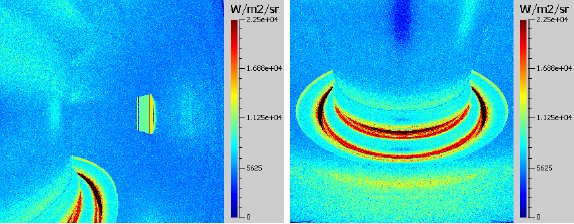
Simulated infrared pictures of ITER divertor
and inside wall |
|
| |
|
|
06/2010 |
Success for the first test of a prototype
conductor of ITER poloidal field coils |
| |
|
In order to define the test procedures
and the acceptance criteria during the manufacture of the poloidal
field coil (PF) conductor of ITER, IO (ITER Organization) ordered
the study, the design and the realisation of 2 samples to ENEA (Italy),
in collaboration with CEA/IRFM. IO provided the raw conductor, the
ENEA dealt with the “jacketing” and the manufacture of the lower
box, the IRFM dealt with the realisation of the terminals and the
instrumentation. The two teams worked in close cooperation,
completing the preparation of the first sample, which was tested
successfully on the test bench SULTAN of the institute Paul Scherrer
located at Villigen (Swiss). The second sample should arrive at the
CEA for finalisation at the beginning of June and testing on SULTAN
at the end of June. In the frame of another ITER contract, the CEA
also participates to the supervision and the analysis of the results
of the tests of these samples. The tests carried out on the first
sample indicate good performances and a temperature margin (with I =
35kA and B = 3.5T) approximately 0.1K higher than initially foreseen.
These good performances confirm the
quality of the PF conductor design, as well as the validity of the
work realised by the ENEA and IRFM teams during the manufacture and
instrumentation stages of the sample. This constitutes an important
and promising step on the critical path to qualify the ITER PF
conductors. |
|
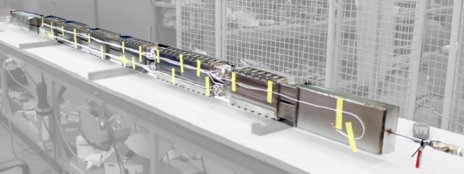
Prototype conductor of ITER poloidal field
coils |
|
| |
|
|
06/2010 |
An unexpected plasma scenario on Tore Supra |
| |
|
During the inspection of the inside of
Tore Supra following the last experimental campaign, damages were
discovered on an actively cooled protection facing the plasma, which
could have caused to a water leak.
After reviewing all the plasma
discharges in which these damages could have occurred and having
visualised the films of the CCD camera observing the damaged zone,
only one plasma discharge (n° 45565) is identified to be responsible.
Correspondent at one experimental session of plasma heating study,
this discharge does not present any particular anomaly, except
during the last phase of extinction (end of the current decrease)
where a disruption occurs. During this incident the camera shows an
intense light on one of the damaged zones. A detailed study of this
plasma indicates the creation of extremely energetic electrons
during the very end of the current ramp-down, in a phase where
plasma density and current are very weak. The simulation of the
magnetic topology shows small plasma positioned at the top of Tore
Supra vessel; the one of the energetic electron trajectories
evidences the existence of a focusing point located behind the
protections corresponding to one of the damaged zones. The
observation of such melting points caused in the ultimate phase of
the discharge, where plasma contains very little energy, is
unexpected and contributes to increase the base of knowledge for the
ITER reliable operation. Concerning Tore Supra, plasma controls will
be modified to guarantee a sufficient plasma density, even during
the current decrease phase, thus avoiding the acceleration of the
electrons. |
|

The damaged component |
|
| |
|
|
04/2010 |
Diagnostic D(E)REVE operational on Tore Supra |
| |
|
New diagnostic DREVE (Vertical
Reflectometry Diagnostic) based on radar techniques has recently
delivered its first signals on Tore Supra. The association of this
new system with an existing one, already on Tore Supra, will extend
the correlation domain of the density fluctuations and their speeds
to larger scales. This is a key ingredient to understand the
behaviour of the turbulence and its link with the transport to
obtain high performance plasmas with improved confinement such
in ITER or JET in H mode.
This new system, using radar techniques,
is based on diffusion effects, due to the plasma density
fluctuations generated by turbulence, on a probe wave. Various
incidence angles of the probe wave correspond to various scales of
the density fluctuations; whereas the temporal analysis of the
retro-diffused wave gives the speed.
DREVE was designed and built within the
framework of a close cooperation between the
Laboratoire de Physique
des Plasma (LPP, Ecole Polytechnique) and the IRFM. |
|

The new diagnostic DREVE in Tore Supra |
|
| |
|
|
03/2010 |
A "premičre" on Tore Supra |
| |
|
2.7 MW coupled during
80 seconds to a Tore Supra stationary plasma, representing 223MJ of
energy injected inside the plasma: it is the latest result recently
obtained using the new passive active multijunction lower hybrid
antenna recently installed on Tore Supra. Most of the plasma current
(900A) has been non inductively driven, and the electron temperature
has been increased by a factor of 2. Meanwhile, thanks to the
efficient cooling of this new design, the temperature of the antenna
and of its protection were kept very low (< 250°C).
This is an excellent
omen to the next experimental campaign of Tore Supra that will
benefit from the new capabilities brought by the completion of the
CIMES project. It is also one more asset for considering the
installation of a lower hybrid current drive system on ITER. |
|

2.7 MW of hybrid power during 80s |
|
| |
|
|
03/2010 |
Mitigation of the disruptions |
| |
|
The last results obtained on Tore Supra
show that it is possible to mitigate the undesirable effects of
disruptions using massive gas injection. It was shown that the
lighter the injected gas is (helium), the quicker it penetrates into
the plasma and the better is the damping of the energetic electrons
(runaways) created during the disruption.
Disruptions are violent events; they
occur spontaneously in tokamak plasma and consist of a brutal loss
of the plasma balance and confinement leading to the end of the
discharge. These events can be dangerous for the machine, via
thermal loading of the plasma facing components, via electromagnetic
forces leading to high mechanical constraints on the structures and
via the generation of highly energetic runaway electrons that hits
the walls. It is thus necessary to mitigate these deleterious
effects.
Injection of a great quantity of gas
into the plasma is one of the methods currently studied. Tore Supra
is equipped with a massive gas injector making possible to test this
technique, and with a large set of diagnostics to study it. In
particular, a fast camera is able to follow the penetration of
neutral gas into the plasma and to study its dynamic. (See picture)
The main aim of these experiments is to understand the physical
mechanisms leading to the mitigation of the disruption, to determine
an optimal gas injection scenario (heavy and light gas mixture) that
can be extrapolated to ITER. On present fusion devices, the plasma
energy is relatively low, so that disruptions are only a minor
inconvenience. However, on ITER, the plasma stored energy will be
100 times larger, and the consequences on the integrity of the
machine will be much more severe. Disruption mitigation is thus a
research programme of great interest for preparing ITER
exploitation.
|
|
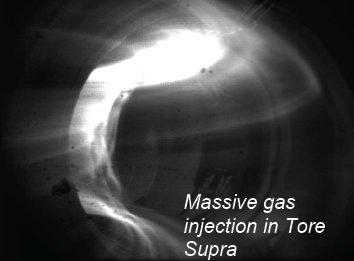
|
|
| |
|
|
04/03/2010 |
Budding future plasma physicists |
| |
|
One of the March experimental runs of
Tore Supra has been devoted to the training of students (within the
master's degree
Sciences
de la Fusion) for enlarging their theoretical studies by some
experimental works (see Le master Sciences de la Fusion.
A student team has been able to realise
the first Tokamak experiment of the master "science de la fusion", a
"premičre" greatly appreciated by these fusion novices. Coming from
Nancy, Marseille and Ile de France universities, these students were
gathered at Cadarache from February the 4th to march the 5th, thanks
to the financial and logistic helps of the INSTN, the Cadarache
centre and the IRFM.
They ended their stay by practicals
using experimental platform of the Tore Supra tokamak. Three
subjects have been proposed:
-Qualification of plasma facing components
-Measurements of the critical current inside a superconducting strand,
using the BRENICE station.
-Studies of the confinement regimes of ohmic Tore Supra plasmas.
The main goal of these experimental
works was to initiate the students to the techniques used on fusion
devices. Such initiation was really appreciated by the students and
will be repeated in the future..
For further information:
 Master's
degree "Sciences de la Fusion"
Master's
degree "Sciences de la Fusion"
|
|

Studients from the master's degree "Sciences
de la Fusion" inside the control room of Tore Supra |
|
| |
|
|
12/11/2009 |
2008 Progress report of the IRFM |
| |
This report describes 2008 activities performed by IRFM.
|
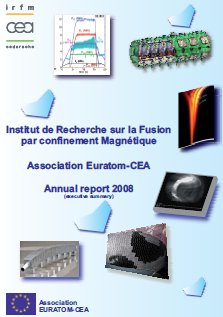
Institut de Recherche sur la
Fusion par Confinement Magnérique
Association Euratom-CEA
Annual report 2008
|
 Summary (17p, pdf, 3.6 Mo)
Summary (17p, pdf, 3.6 Mo)
 Full
report (139p, pdf, 7.5 Mo)
Full
report (139p, pdf, 7.5 Mo)
Contents:
1 - Introduction
2 -
Tore Supra status
3 -
Theory & modelling
4 -
Experimental physics
5 -
Technology developments
6 -
Participation to W7X construction
7 -
Broader approach activities
8 -
Other activities
9 -
Appendices
|
|
|
0707/2009 |
Fusion Technology : 2007-2008 activity report of the Association Euratom-CEA |
| |
This annual report presents research activities, which have been performed in 2007-2008 by the French EURATOM-CEA
Association within the frame of the European Technology Programme.
|
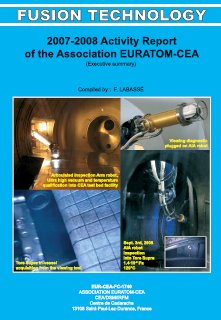
Fusion Technology : 2007-2008 activity
report of the Association Euratom-CEA.
|
 Executive
Summary (38p, pdf, 2.4 Mo)
Executive
Summary (38p, pdf, 2.4 Mo)
 Full
report (391p, pdf, 26 Mo)
Full
report (391p, pdf, 26 Mo)
|
|
| |
|
|
06/02/2009 |
Feasibility demonstration of laser ablation
techniques inside Tore Supra vacuum vessel |
| |
|
During
Tore Supra experiments, plasma facing components are eroded,
especially in high heat flux area. This eroded matter creates
deposited layers which can in a first hand trap hydrogen, deuterium
and tritium and in a second hand, become an issue for plasma operation.
Manual cleaning of plasma facing component is performed inside Tore
Supra but will be not possible on ITER. Therefore, new laser cleaning
techniques are developed by Euratom-CEA in close collaboration with a
CEA laboratory (DEN/DPC) and University (CNRS/LP3, Marseille).
On 06/02/2009, a
demonstration of laser ablation techniques inside Tore Supra vacuum
vessel has been performed, at room temperature and atmospheric
pressure.
For further information:
 Read the full document
Read the full document 
 File
Tore Supra File
Tore Supra
|
|
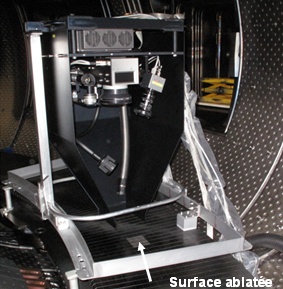
Laser Ablation techniques inside Tore Supra |
|
|
30/10/2008 |
2004-2007 Progress report of the IRFM |
| |
This report describes
2004-2007 activities performed by IRFM
|
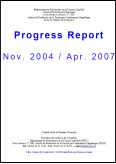
Rapport d'activité 2004-2007
(204 pages, 19Mo, PDF,
 ) )
|
Contents
:
1. INTRODUCTION
2. SCIENTIFIC ACTIVITIES
3. PLASMA ENGINEERING
4. INTEGRATION AND NUCLEAR SYSTEMS
5. OPERATION
6. ITER SITE
7. PUBLICATIONS
See the
Full report
(204 pages, 19Mo, PDF,  )) ))
See the
Summary
( 16 pages, 0.5Mo, PDF,  )) )) |
|
| |
|
|
03/09/2008 |
First deployments and inspections of the Articulated Inspection Arm (AIA) under Ultra High Vacuum and high temperature inside Tore Supra |
| |
|
The first deployments of the
Articulated Inspection Arm (AIA) inside Tore Supra under Ultra High
Vacuum conditions (1,4.10-5 Pa ) and temperature (120°C) proceeded successfully on September 3rd, 2008.
After
the vessel inspection, the experimental campaign of Tore Supra started
without conditioning. This deployment is an important step toward the
demonstration of remote handling inspection of the Iter components.
 see the
movie of the inspection
see the
movie of the inspection
For further information:
 Read the full document
Read the full document 
 File
Tore Supra File
Tore Supra
|
|
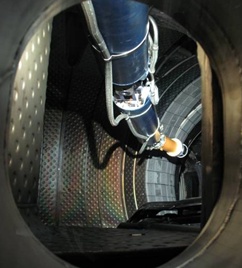
First deployments and inspections of the Articulated Inspection Arm (AIA)
inside Tore Supra under vacuum and temperature conditions (13-09-2007) |
|
|
26/10/2007 |
20th anniversary of Tore Supra |
| |
|
IOn April 1st 2008, a
celebration took place at the Institute for Magnetic Fusion Research
at the occasion of the 20th anniversary of the Tore Supra first
plasma.
This was an excellent
opportunity to gather several generations of physicists and engineers
that had designed, built and operated Tore Supra. Before a convivial
buffet, several staff of the Institute, either retired or in activity,
recounted the Tore Supra adventure through various anecdotes that have
marked them: industrialisation problems of NbTi superconducting cables;
design of Tore Supra essentially conducted with drawing tables and
slide rules; unbelief of foreign colleagues that a superfluid helium
bath could properly cool down superconductors; atmosphere in the
control room on the night between March 31th and April 1st 1988 with a
scoop: the first plasma of Tore Supra probably happened on March 31th;
evolution of power exhaust tools from the ergodic divertor to the
toroidal pumped limiter; progress toward the 6 minutes duration
discharge; the limiter deuterium loading campaign with its 5 hours of
plasma concentrated on 10 operational days; the saga of the klystrons
for current drive from the choice of the 3,7 GHz frequency up to the
latest technological developments for the CIMES project.
Beneath the physics
findings and the technological achievements, the human and team spirit
aspects really shown through. Jean Jacquinot, former Head of the
Institute and Y. Caristan, Director of the “Direction des Sciences de
la Matičre” conveyed through remote participation their
congratulations and encouragements to the Institute staff. Looking
towards future prospects for Tore Supra concluded the presentations.
The last word was given by R. Aymar, Tore Supra project manager and
presently director of CERN who advised young scientists to always be
able to keep a long ranging view on the future by always preparing the
next step.
 File
Tore Supra File
Tore Supra
|
|
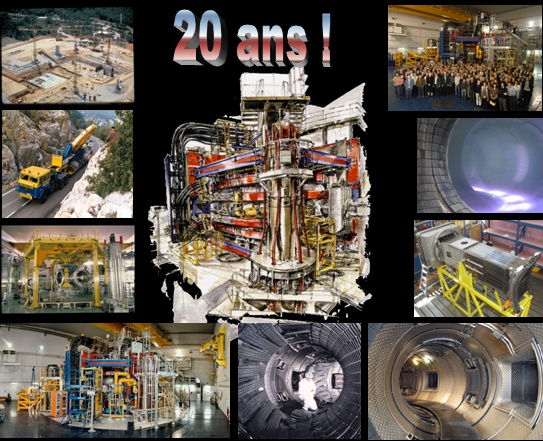
|
|
|
26/10/2007 |
1400 participants at the ICFRM13 and IBF/07 |
| |
|
ICFRM conferences are
held every two years in one of the fusion partner countries,
alternating between Europe, Asia, and the USA. In this series, the
13th conference, organised by CEA, takes a special place in several aspects:
- first major materials conference after the ITER site decision.
- first ICFRM conference with major industrial exhibition (IBF/07)
- first conference targeting synergy between fusion and fission materials.
Together, the two
events, ICFRM and IBF, attracted about 1400 delegates from the
scientific community and industry, as well as, 80 exhibitors. The two
events were managed in a way that allowed maximum encounter between
the participants, including free circulation of attendees between
parallel industrial and material sessions.
Delegates from 33
countries attended the ICFRM conference, with new ITER partners
marking an increased presence. For the first time, the conference
welcomed delegates from several countries outside the ITER and IEA
communities.
The scientific content
of the two events was marked by: over 150 oral presentations, 500
posters, and 15 workshops. The number of abstracts received per topic
reflected the evolution of the fusion programme. For instance, as we
approach the ITER construction phase, the need for R&D work on
conventional materials such as 316L(N)-IG steel has diminished, and
more emphasis is placed on manufacturing of components and licensing.
Several session was
dedicated to the effect of radiation on the behavior of functional and
structural materials. Furthermore, with the increasing
availability of powerful computational tools, multiscale modelling of
materials behaviour is rapidly advancing, as shown by a large number
of papers in this sector.
The next ICFRM will be
held in Satorro (Japan) on september 2009.
 ICFRM13 website
ICFRM13 website
 IBF/07 website
IBF/07 website
|
|
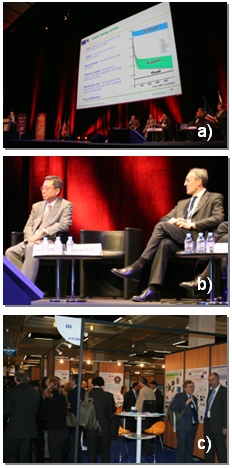
a) during the opening session
b) K. Ikepa (Iter DG) and B. Bigot (french high
commissioner
for nuclear energy) during the opening
session
c) industrial showroom |
|
|
26/10/2007 |
Integrated modelling of fusion plasma whith
the CRONOS code |
| |
|
With the ITER project,
integrated modelling of plasma discharges is becoming an increasingly
important objective, taking on its full scope and significance. Like
any nuclear installation, ITER needs to have a simulator, i.e.
software capable of predicting the complete evolution of a discharge,
using control parameters. The existence and reliable operation of this
simulator will play an important role in the safety of the reactor,
for optimising the operation of the machine, and for programming
campaigns of scientific experiments.
The CRONOS code (developed
by the Euratom-CEA Association) is part of the small group of
numerical suites on which the integrated modelling of thermonuclear
plasmas is based at an international level.
 Read the full document
Read the full document
|
|
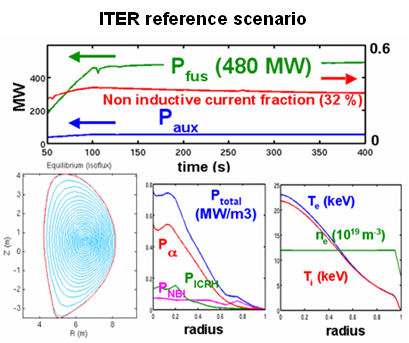
Simulation du plasma de référence d'ITER
par le code CRONOS |
|
|
13/09/2007 |
First deployments and inspections of the Articulated Inspection Arm (AIA)
inside Tore Supra |
| |
|
Since 2003, the
Euratom-CEA Association has developped a R&D program and the
qualification of a poly-articulated arm called AIA (Articulated
Inspection ARM) able to operate inside a Tokamak vacuum vessel.
The first deployments of the robot inside Tore Supra under
atmospheric conditions proceeded successfully on September 13rd, 2007.
 Read the full document
Read the full document 
For further information:
 File
Tore Supra File
Tore Supra
|
|
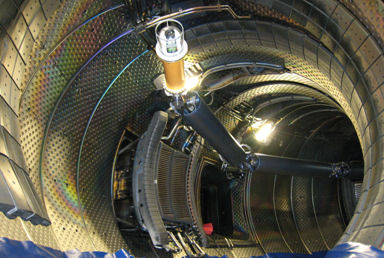
First deployments and inspections of the Articulated Inspection Arm (AIA)
inside Tore Supra(13-09-2007) |
|
|
10/09/2007 |
A new infrared diagnostic delivered at JET |
| |
|
The Euratom-ECA Association has designed
and manufactured within the framework of the European program on
fusion an infrared thermography diagnostic for the JET allowing an
in-situ monitoring of the plasma facing components. Its main feature
is to use technologies which could be implemented for such diagnostic
in ITER.
The diagnosis was officially accepted by
the Operator of the JET in September 2007.
 Read the full document
Read the full document 
For further information:
 EFDA-JET
website EFDA-JET
website
 |
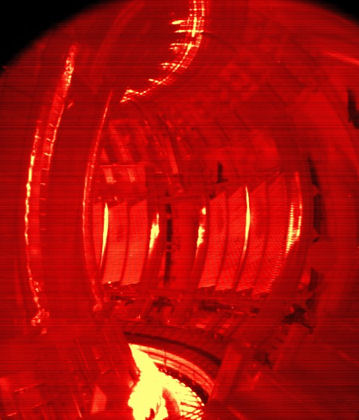
Infrared imaging of the JET vacuum vessel
during plasma |
|
| |
|
|
17/07/2007 |
The European Joint Undertaking for ITER and the
Development of Fusion Energy ('Fusion for Energy') appoints its first
Director |
| |
Didier
Gambier has been appointed (17/07/2007) as first director of the European
Joint Undertaking for ITER and the Development of Fusion Energy ('Fusion
for Energy). F4E will provide the European contributions to the ITER
International Fusion Energy project, the Broader Approach Agreement with
Japan as well as to prepare for demonstration fusion reactors. It is
planned that F4E will become operational towards the end of 2007.
For further information:
 Press release
(pdf)
Press release
(pdf)
 F4E website :
http://fusionforenergy.europa.eu/ F4E website :
http://fusionforenergy.europa.eu/

 Broader Approach:
Joint
attachment to ITER Parties agreement (28/06/2005) (pdf) Broader Approach:
Joint
attachment to ITER Parties agreement (28/06/2005) (pdf)
|
| |
|
|
18/06/2007 |
"Fusion
technology, Annual report of the Association Euratom-CEA, 2006" |
| |
This annual report presents research activities, which have been performed in 2006 by the French EURATOM-CEA
Association within the frame of the European Technology Programme. (see also
CEA
activities : ITER and future reactor)
|
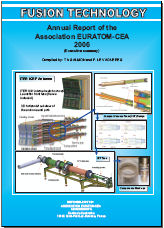
Fusion
Technology : Annuel Report of the Association Euratom-CEA.
2006 activities
(June 2007)

|
 Executive
Summary
(45p, pdf, 4.2 Mo)
Executive
Summary
(45p, pdf, 4.2 Mo)
 Full
report (422p, pdf,
53 Mo)
Full
report (422p, pdf,
53 Mo)
|
|
| |
|
|
08/06/2007 |
SATIR device is ready to participating to the
ITER plasma facing components qualification |
| |
|
The so-called SATIR
(Station d’Acquisition et Traitement InfraRouge) device is used to
qualify plasma facing components. It strongly contributed to the
success of CIEL components manufacturing. This device has been
updated and is now able to test ITER components with increased
performance.
 Read the full document
Read the full document 
|
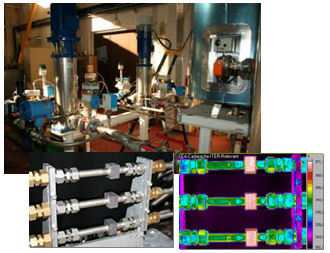
SATIR device andv iew of 3 components
during testing
|
|
| |
|
|
16/12/2006 |
SURVIE:
a new diagnostic for plasma facing components security
|
| |
|
A new diagnostic,
so-called SURVIE (french acronym for Surveillance Rapide des Impuretés
dans l'Ultra Violet Extręme) is in operation at Tore Supra. SURVIE is
dedicated to plasma facing components security.
For further information:
see the article diagnostic
SURVIE,  |
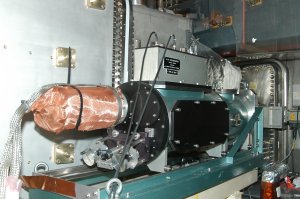
SURVIE diagostic
instaled on Tore Supra |
|
| |
|
|
16/11/2006 |
5D modelling of the plasma turbulence runs on
the super computerTera10 |
| |
|
The GYSELA code (GYrokinetic
SEmi-LAgrangian) is able to model plasma turbulence in toroidal
geometry. It uses original numerical methods. Such a 5D code needs a
huge computing resources. Within the framework of the “Grand
Challenge” project, first GYSELA runs have been done on the super
computer Tera10, available at CEA/DAM (50 Tera-Flops, 8000
processors).
For further information:
see the article
Modélisation ŕ
cinq dimensions de la turbulence dans un plasma de Tokamak,  |
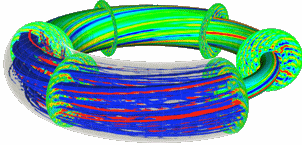
GYSELA code simulation
on the super computer Tera10 |
|
| |
|
|
14/11/2006 |
Iter, le chemin des étoiles ? a book about ITER |
| |
A book about Iter, written
by Jean Jacquinot, former Head of CEA Fusion Laboratory and Robert Arnoux,
reporter, is available. This book describes with details and a lot of
pictures, the fusion and Iter saga.
Contents in french :
-
Prologue
-
Chapitre 1: Dans
l'intimité de l'atome
-
Chapitre 2: Du
nucléaire au thermonucléaire
-
Chapitre 3: Le démon
est dans le plasma
-
Chapitre 4: Le JET ou
la fusion pour de vrai
-
Chapitre 5: Les chauds
et frods de Tore supra
-
Chapitre 6: Y a-t-il
une vie aprčs le pétrole ?
-
Chapitre 7: Il faut
sauver le programme ITER
-
Chapitre 8: L'Europe
choisi son site
-
Chapitre 9: Six
partenaires en quęte d'un accord
-
Chapitre 10: Cadarache,
un concentré d'énergies
-
Chapitre 11: Toute une
région mobilisée
-
Questions
-
Épilogue
-
Annexes
-
Bibliographie
For further
information :
|
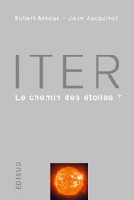
Robert
Arnoux et Jean Jacquinot,
2006, ISBN 2-7449-0615-8
Edition : EDISUD, 
|
|
| |
|
|
01/08/2006 |
"Fusion
technology, Annual report of the Association Euratom-CEA, 2005" |
| |
This annual report presents research activities, which have been performed in 2005 by the French EURATOM-CEA
Association within the frame of the European Technology Programme. (see also
CEA
activities : ITER and future reactor)
|
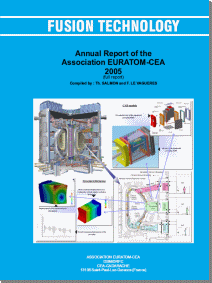
Fusion
Technology : Annuel Report of the Association Euratom-CEA.
2005 activities
(July 2006)

|
 Executive
Summary
(39p, pdf, 2 936 Ko)
Executive
Summary
(39p, pdf, 2 936 Ko)
 Full
report (432p, pdf, 45 772 Ko)
Full
report (432p, pdf, 45 772 Ko)
|
|
| |
|
|
09/06/2006 |
Prime Minister in Cadarache |
| |
Dominique de Villepin, the French Prime
Minister visited the ITER site and Tore supra facility in Cadarache (Prime
Minister's speech or
PDF  ) )
|
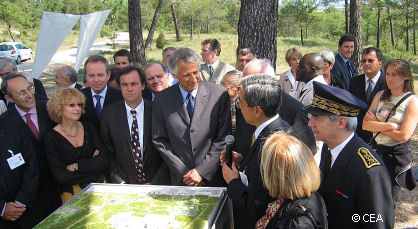
Visiting the ITER site in Cadarache with
K. Ikeda, ITER Director..
|
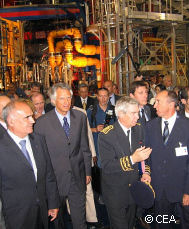
Visiting Tore Supra : |
|
| |
|
|
07/12/2005 |
Chinese
Premier Wen Jiabao visited Tore Supra and the ITER site |
| |
|
The
Chinese Premier Wen Jiabao visited the International Thermonuclear
Experimental Reactor site situated in Cadarache. He also visited
Tore Supra accompanied by Francois Loos, Minister for Industry,
industrials and local politicians.
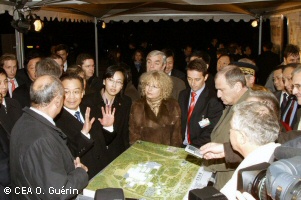
Visiting the ITER site in Cadarache
|
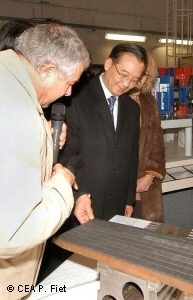
Visiting Tore Supra : Chinese Premier
Wen Jiabao listens to explanations about plasma facing
components by Michel Chatelier, Head of the Research
Controlled Fusion Department
|
|
| |
|
| 06/12/2005 |
India was welcomed by the other partners as a full partner in the ITER project |
| |
|
| |
|
| 03/07/2005 |
Commissioner
Potočnik visited the ITER site and Tore Supra |
| |
European Commissioner for Science and Research, Janez Potočnik visited the site in France that was chosen to host the international fusion research facility ITER. In the company of representatives of the French government and the European fusion research community, he saluted the co-operation among all European players in fusion that had made it possible to achieve this positive outcome.
|
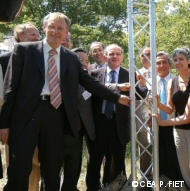
Visiting the ITER site in Cadarache
|
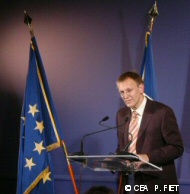
Commissioner Potocnik during his speech
|
|
| |
|
| 30/06/2005 |
President Jacques Chirac in Cadarache. |
| |
|
President Jacques
Chirac visited Cadarache to thank fusion staff that had made it
possible to achieve the success of the Cadarache site to host ITER.
President Jacques Chirac also visited the ITER site and Tore Supra
device. Representatives of the French government and local
politicians accompanied Jacques Chirac during the visit.
President Jacques
Chirac's speech (  ) )
For further information :
 www.iter.gouv.fr www.iter.gouv.fr

About ITER :
 www.itercad.org www.itercad.org

 ITER ITER
|

Visiting Tore Supra : Michel Chatelier, Head
of the Research Controlled Fusion Department presenting fusion
technologies to Jacques Chirac.

President Jacques Chirac during his
speech.
|
|
| |
|
| 28/06/2005 |
The Six Parties participating in the ITER project decided to build this project in Cadarache in Southern France |
| |
|
An agreement has been signed
on 28/06/2005f
in Moscow between the ITER Parties to build ITER in Cadarache, France
See the "joint
declaration" and the "joint
attachment" |
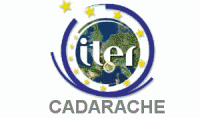 |
For further information :
 www.iter.gouv.fr www.iter.gouv.fr

About ITER :
 www.itercad.org www.itercad.org

 ITER ITER
|
| |
|
| 27/06/2005 |
"Fusion
technology, Annual report of the Association Euratom-CEA, 2004" |
| |
his annual report presents research activities, which have been performed in 2004 by the French EURATOM-CEA
Association within the frame of the European Technology Programme. (see also
CEA
activities : ITER and future reactor)
|
| |
|
| 26/11/2004 |
EU ministers
confirm the European support to build the ITER project on the European site (EU Council Meeting of
Competitiveness) |
| |
For further information :
 www.iter.gouv.fr www.iter.gouv.fr

About ITER :
 www.itercad.org www.itercad.org

 ITER ITER
|
| |
|
| 1-6/11/2004 |
20th
IAEA Fusion Energy Conférence (1-6/11/2002,Vilamora) |
|
|
Recent results obtained on
Tore Supra are presented during the 20-th international Conference on the Energy of Fusion.
The main results are :
- the 6minutes 30s plasma discharge and the world record of
injected/extracted energy in Tore Supra (1.1 GJ)
- the existence of anomalous particle pinch has been unambiguously proven.
This result could improve by 30% the ITER plasma performance
Jean Jacquinot, head
of "Département de Recherches sur la
Fusion Contrôlée, presented an overview of last results "Steady-State Operation of Tokamaks: Key Physics and Technology
Developments on Tore Supra".
Access to
the article (PDF, 654ko) and slideshow
(PDF, 84ko) :
For further information :
- Website
of the 20th IAEA conference

- list
of Euratom-CEA papers
|
| 30/09/2004 |
M.
François d’Aubert, French minister responsible for Research,
visited European ITER site and Tore Supra |
|
|
On
Thursday 30/09/2004, the French minister responsible for Research M. François
d’Aubert, the Chairman of the "Provence Alpes Cote d'Azur"
(PACA) region council and local politicians and representatives visited
thr European ITER site and Tore Supra in Cadarache. Mr Alain Bugat,
chairman of the CEA and Jean Jacquinot, Head of the Research Controlled
Fusion Department accompanied M. François d’Aubert.
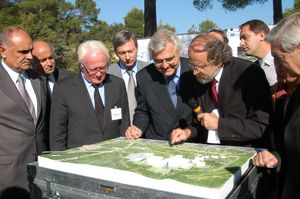
Visiting the ITER site : Jean Jacquinot,
Head
of the Research Controlled Fusion Department presenting the site to
the minister and to the Chairman
of the "Provence Alpes Cote d'Azur" region council |
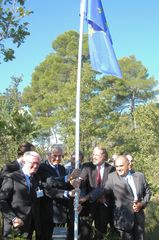 |
Visiting the ITER site :
the flag simulates the magnetic axis of ITER |
|
Mr Jean Jacquinot
presented the ITER site and the results of Tore Supra in the
conference room of Tore Supra.
Mr François d’Auber answered questions and recalled engagements of the French government about the French candidature as well as the exceptional assets of the site of Cadarache. He also recalled decisions taken during the last Council of EU Ministers and in particular the negociation
which are on going to reach an agreement to built ITER in Europe on the basis of an international cooperation as large as possible with at least three partners.
For further information :
 www.iter.gouv.fr www.iter.gouv.fr

About ITER :
 www.itercad.org www.itercad.org

 ITER ITER
|
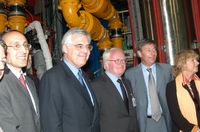
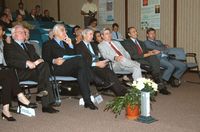
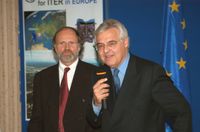 |
Visiting
Tore Supra
Inside the
conference room
The
minister
answering questions |
|
| |
|
| 24/09/2004 |
EU ministers have agreed to launch a major diplomatic effort in order to build the ITER project on the European site (EU Council Meeting of Competitiveness) |
| |
|
The
Council of EU Ministers (Competitiveness: domestic market, industry
and research) asked the European Commission to negotiate and prepare
an agreement concerning construction in Europe, on the site of
Cadarache, of the experimental fusion device ITER. The
framework of this agreement will take place on the basis of an
international cooperation as large as possible with at least three
partners and remaining opened to the present partners of the
project and other potentially interested countries.
The
agreement will include a comprehensive financial framework which
allows ITER construction while preserving a vigorous accompanying
programme of research and technological development in order to
accelerate the development of the fusion energy.
The result of these negotiations will be presented
at the next session of the Council, at (25 and 26 November 2004), to reach agreement on the main elements of the future international agreement on ITER.
Press
Release (draf) Council of the European Union, Competitiveness (Internal Market, Industry and Research), 24/09/2004 (PDF)
or WebSite
of the European Council

|
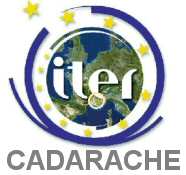
|
For further information :
 www.iter.gouv.fr www.iter.gouv.fr

About ITER :
 www.itercad.org www.itercad.org

 ITER ITER
|
| |
|
| 22/06/2004 |
Progress
report of the Département de Recherches sur la Fusion Contrôlée |
| |
This report describes
2000-2001 activities involved by the "Département de Recherches sur la Fusion Contrôlée"
(DRFC).
|
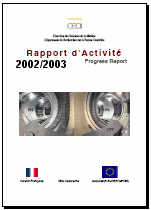
2000-2001 DRFC Progress Report
(230 pages, 11Mo, PDF,  ) )
|
Contents
:
- ITER site
- Tore Supra program : evolution
- Tore Supra : physics studies
- Tore Supra : sub-system operation,
maintenance and enhancement
- Participation in JET operation
- Developments for the next step and the
long term
- Collaborations
- Communication
- Appendix
This report is only
available in French  |
|
| |
|
| 11/06/2004 |
"Fusion
technology, Annual report of the Association Euratom-CEA, 2003" |
| |
This annual report presents research
activities, which have been performed in 2003 by the French EURATOM-CEA
Association in the frame of the European Technology Programme. (see also
CEA
activities : ITER and future reactor)
|
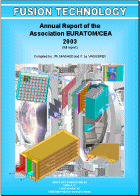
Fusion
Technology : Annuel Report of the Association Euratom-CEA.
Juin 2003

|
 Executive
Summary (30p, pdf, 3 179 Ko) Executive
Summary (30p, pdf, 3 179 Ko)
 Full
report (385p, pdf, 36 771 Ko) Full
report (385p, pdf, 36 771 Ko)
- Cover,
contents, introduction (14p,
pdf,1 683 Ko)
- Plasma
integration (47p,
pdf, 4 857 Ko)
- Plasma
facing components (57p, pdf, 5 958ko)
- Vessel/In
Vessel (37p, pdf, 4 223 Ko)
- Remote
Handling (53p, pdf, 6 756 Ko)
- Magnets
(37p, pdf, 2 960 ko)
- Breeding
blankets (48p, pdf, 14 706 ko)
- Structural
materials (91p, pdf, 8 104 ko)
- Safety
(30p, pdf, 2 692ko)
- Reactor
studies (56p, pdf, 4 630 ko)
- Appendix
(32p, pdf, 1 958 ko)
|
|
| |
|
| 31/01/2004 |
Yan Hua Liu, China's deputy science minister visited Cadarache...
|
| |
Yan Hua Liu, China's
deputy science minister, Renaud Muselier, Secretary of State
for Foreign Affairs and local
politicians visited Tore
Supra and the proposed ITER site in Cadarache. M. Liu confirmed that
China will support Cadarache as the site of the International
Thermonuclear Experimental Reactor project.
|
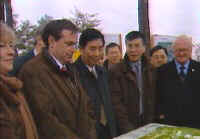
On the ITER site with Renaud
Muselier
and Michel Vauzelle |

Presentation of the high heat flux
components installed
inside Tore Supra |
For further information :
 www.iter.gouv.fr www.iter.gouv.fr

About ITER :
 www.itercad.org www.itercad.org

 ITER ITER
|
| |
|
| 22/12/2003 |
Ministerial
Meeting for ITER on 20th December, 2003 in Washington, DC.
|
| |
Ministers representing
the participants in negotiations on ITER construction (Canada,
China, Europe, Japan, South Korea, the Russian Federation, and the
United States of America) met in Washington. Unfortunately,
they were unable to reach agreement on the site for ITER, and agreed
to meet again after the end of January 2004 For further information :
 www.iter.gouv.fr www.iter.gouv.fr

About ITER :
 www.itercad.org www.itercad.org

 ITER ITER
|
| |
|
| 04/12/2003 |
6minutes
30s plasma discharge in Tore Supra |
| |
One Gigajoules injected,
One Gigajoules extracted ! On December 4th 2003, the engineers and
scientists of the Association Euratom-CEA have achieved a six and a
half minutes long plasma discharge on Tore Supra, sustained by 3MW of
current drive power, thus requiring to exhaust more than 1000
Megajoules of thermal energy during the experiment. It establishes a new
world record in this domain after the 750MJ discharges on September 2002.
For further information :
 Tore
Supra. Tore
Supra.
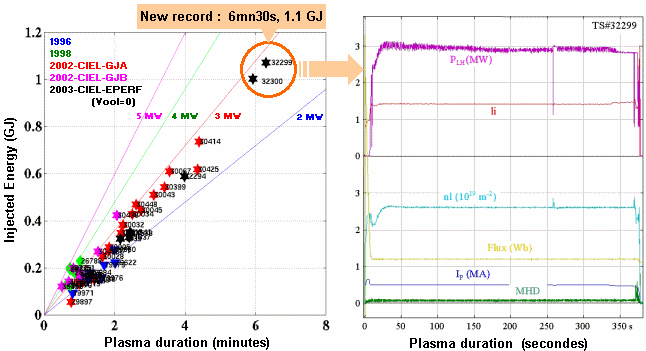
|
| |
|
| 26/11/2003 |
Cadarache,
the European site for ITER. |
| |
For further information :
 www.iter.gouv.fr www.iter.gouv.fr

 www.itercad.org www.itercad.org

 ITER ITER
|
| |
|
| 17/11/2003 |
Prime
Minister and Minister Claudie Haigneré in Cadarache |
| |
Jean-Pierre Raffarin, the French Prime
Minister, Mme
Claudie Haigneré, the French minister responsible for Research and New
Technologies and Renaud Muselier, Secretary of state for foreign affairs visited the propose ITER site in Cadarache.
|
|
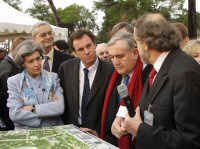
Visiting the ITER site :
explanations from Jean Jacquinot, head of CEA
Research Controlled Fusion Department
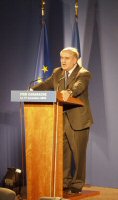
Speech by the Prime Minister
|
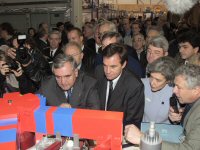
Visiting Tore Supra
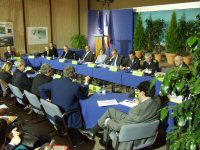
Rond table discussion with local
politicians and representatives of the economic development
structures
|
For further information :
 www.iter.gouv.fr www.iter.gouv.fr

 www.itercad.org www.itercad.org

 ITER ITER
|
| |
|
| 15/07/2003 |
Minister
Claudie Haigneré presents the Cadarache site to Philippe Busquin,
European Commissioner for Research. |
| |
|
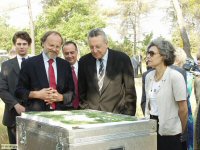
Visiting the ITER site
|
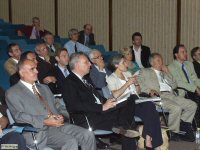 |
For further information :
 www.iter.gouv.fr www.iter.gouv.fr
 / Press
release
/ Press
release

|
| |
|
| 26/06/2003 |
Mme. Claudie
Haigneré (french minister responsible for Research and New
Technologies) presented the
french
ITER site to the european press. |
|
|
On Thursday 26/06/03, Mme
Claudie Haigneré, the french minister responsible for Research and New
Technologies presented the French ITER site to the European press during a
conference about fusion energy in Cadarache.
|
| |
|
| 07/06/2003 |
"Fusion
technology, Annual report of the Association Euratom-CEA, 2002"
|
| |
This annual report presents research
activities, which have been performed in 2002 by the French EURATOM-CEA
Association in the frame of the European Technology Programme. (see also
CEA
activities : ITER and future reactor):
|
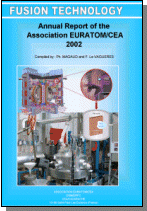
Fusion
Technology : Annuel Report of the Association Euratom-CEA.
Juin 2002

|
- Cover,
contents, introduction (13p,
pdf,1576 ko)
- Plasma
integration (30p, pdf, 5 827 ko)
- Plasma
facing components (37p, pdf, 4387ko)
- Vessel/In
Vessel (58p, pdf, 5 375 ko)
- Remote
Handling (46p, pdf, 5 487 ko)
- Magnets
(30p, pdf, 2 789 ko)
- Breeding
blankets (78p, pdf, 5 965 ko)
- Structural
materials (117p, pdf, 14 312 ko)
- Fuel
cycle (14p, pdf, 896 ko)
- Safety
(32p, pdf, 3 790ko)
- Reactor
studies (56p, pdf, 4 630 ko)
- Inertial
confinement (24p, pdf, 2 170 ko)
- Appendix
(34p, pdf, 1 359 ko)
|
|
| |
|
| 31/03/2003 |
Mme. Claudie
Haigneré (french minister responsible for Research and New
Technologies) visited french
ITER site and Tore Supra |
|
|
On Monday 31/03/2003, Mme
Claudie Haigneré, the french minister responsible for Research and New
Technologies, Mr Michel Vauzel, chairman of the "Provence Alpes Cote
d'Azur" (PACA) region council visited the French ITER site and Tore
Supra device. Mr Alain Bugat, chairman of the CEA and Jean Jacquinot, Head
of the Research Controlled Fusion Department accompanied Mme Claudie
Haigneré and Mr Michel Vauzel.
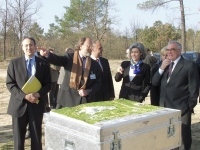
Visiting the ITER site. |
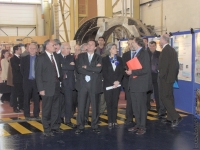
Visiting Tore Supra |
|
Claudie Haigneré expressed the full support of the French government for
the French candidature during a speech to DRFC (Research Controlled Fusion
Department) people.
Claudie
Haigneré's speech

 (or pdf file)
(or pdf file) |
 |
For further information :
 www.iter.gouv.fr www.iter.gouv.fr

 www.itercad.org www.itercad.org

 ITER ITER
|
| |
|
| 02/13/2003 |
Mme. Claudie Haigneré's
speech (french minister responsible for Research and New
Technologies) to the Comité ŕ
l'Energie Atomique, 13 February 2003 |
|
|
At a meeting to the Comité
ŕ l'Energie Atomique (13 February 2003), the french minister responsible for Research and New
Technologies spoke about ITER and
french candidature.
Press release

 (or pdf file)
(or pdf file)
For further information :
 www.itercad.org www.itercad.org

 ITER ITER
|
| |
|
| 30/01/2003 |
US
and China will join ITER |
|
|
President Bush has decided
that the U.S. will join the negotiations for the construction and
operation of a major international magnetic fusion research project. The
U.S. share of the construction is expected to be 10 percent of the total.
Press release
(US DOE website)

Following the visit of the
ITER negotiators in China in November 2002, the Chinese Minister of
Science and Technology, wrote in January on behalf of this government, to
the four heads of delegation in the ITER negotiations, requesting that
China participate in the present ITER negotiations.
China and US delegation will
participate to the next negotiations meeting, 17 February in St.
Petersburg, Russia.
|
| |
|
| 30/01/2003 |
France
confirms that Cadarache will be a candidate to host ITER |
|
|
During a meeting of the
ministers dealing with the ITER and chaired by the Prime Minister, France
has decided to confirm that Cadarache will be a candidate to host ITER.
Press release
 (or pdf file)
(or pdf file)
For further information :
 ITER ITER
|
| |
|
| 17/01/2003 |
Web
site about Cadarache as european site for ITER |
|
|
|
| |
|
| 2001-2002 |
Archives
2001-2002
|
| |
|